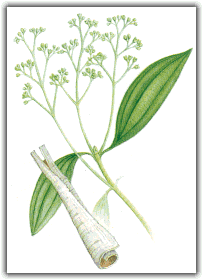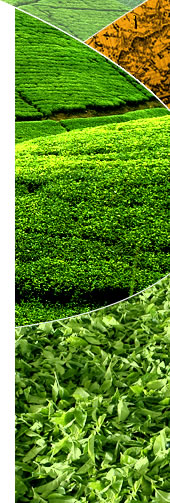| |
 |
![]()
Cooper's Chronicles: Cinnamon
THE SCINTILLATING CINNAMON
By Barry P.W. Cooper
A very hot flavor in the marketplace at the moment is cinnamon. It is used in a variety of ways since the early days of man, and cinnamon has recently found a new lease on life as a base for many beverages – it is rumored that some branded cola products have a percentage of cinnamon in their base syrup. However, it is in herb teas that cinnamon has recently surged to the forefront.
 Unlike many other herbal ingredients which are light and fluffy and difficult to pack, cinnamon is a bark that, once reduced to manageable tea bag size, has the same flow characteristics as black tea. This makes it very popular with the production floor managers and equally so with the tasters where cinnamon's sweet and aromatic characters can be used in numerous ways to enhance a beverage.
Unlike many other herbal ingredients which are light and fluffy and difficult to pack, cinnamon is a bark that, once reduced to manageable tea bag size, has the same flow characteristics as black tea. This makes it very popular with the production floor managers and equally so with the tasters where cinnamon's sweet and aromatic characters can be used in numerous ways to enhance a beverage.
Cinnamon is in the Lauraceae family. It is an evergreen tree that is commercially useable within four years of planting and can live up to 1,000 years. All commercial cinnamon are the same genus but different species Cinnamomum zeylandica is the true cinnamon from Sri Lanka which is generally preferred by the Europeans and Latin Americans. The American market uses two primary species: C. Cassia, and C. Burmannii. The first is a native of China, the second from Indonesia. The Burmannii is called "korintji" because it is grown in the Korintji region on the west coast of Sumatra in Indonesia.
The word cassia comes from ancient languages – Greek "cassia" meaning "strip off" bark and the Hebrew verb "quetsiah" meaning to "cut off" and mention of the spice can be found in the books of Exodus, Psalms and Ezekial variously as qinnamon, qiddah and qetzioth.
Cinnamon trees must be at least four years old before they are coppiced or topped off so the tree will sprout shoots. These new shoots are then harvested and the bark is stripped and scraped for sale. The harvesting is easiest in the rainy season, but the bark can be stripped at any time of the year.
For higher grades of cinnamon, the collector marks the bark at one meter lengths and then cuts a circle around the base of the tree and at the tip of the meter mark. It is then carefully stripped. The outer bark is removed with a scraper and then sun-dried. As it dries it curls to form the familiar quill. The upper portion of the trunk has a gray outer bark and has less oil therefore generating less flavor – and is correspondingly less expensive.
The different grades of bark are transported to a central market where they are sold and then cleaned before packing and export. The cleaning consists of soaking the quills so that the workers can wash off any dirt and insects. The quills are then dried on concrete patios, and when dry, are cut with a saw into manageable lengths.
Cinnamon contains volatile oils with such light molecules that the aromatics dissipate easily and evaporate when in contact with air. Non-volatile or fixed oils are much less aromatic and become resinous when exposed to air, similar to cooking oils. The volatile oil content is important to the buyer because the price of cassia is determined by the percentage of volatile oil found present in the bark. The higher the percentage of oil, the higher the asking price.
The cinnamon market is well-defined and is driven to a certain extent by supply and demand. A thriving spot market in New York exists for cinnamon for everything ranging from the high oil content material at three percent, to the broken pieces of cinnamon with an oil content of less than one percent.
As the oil content is so indicative of quality, not much processing has been done at origin. It was feared that processing the product at origin would cause volatile oils to be lost in transit, thus reducing the value of the item upon its arrival. That may have been true in the days when Hessian sacking was the only packing available, but now with sophisticated vacuum systems and sacks with foil linings commonly available overseas, it is possible to cut the cinnamon into tea bag form at origin and retain the volatile oil content during shipment, taking advantage of the low overheads of overseas manufacturing.
It is the aromatics that make cinnamon such a desirable ingredient in many herbal blends, although recent research in Japan has shown that cinnamon contains a substance that kills fungi, bacteria and other microorganisms such as "Clostridium botulinum" which causes botulism and "Staphylococcus aureus" a source of staph infection. It has also been effective in combating "A. flavus" a fungi that produces aflatoxin. These findings suggest all kinds of possible medicinal uses for cinnamon and probably explains why, since the earliest of time, it has been one of man's favorite spices, AFLATOXIN.
The entry of cassia into the field of herb tea and ready to drink beverages is just one more example of cinnamon's continued proud versatile heritage in its service to mankind.

|
|